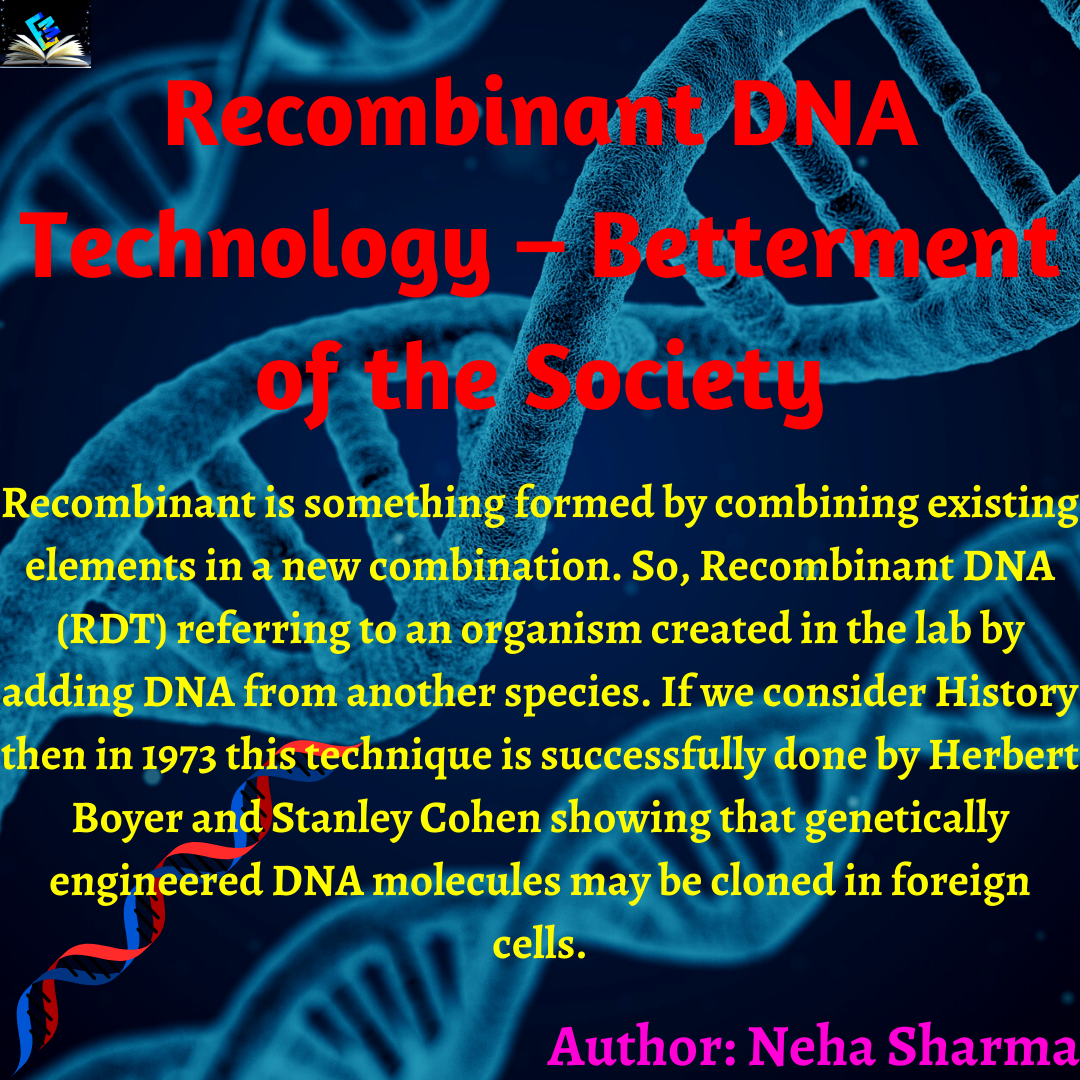
Recombinant DNA Technology – Betterment of the Society
Recombinant is something formed by combining existing elements in a new combination. So, Recombinant DNA (RDT) referring to an organism created in the lab by adding DNA from another species. If we consider History then in 1973 this technique is successfully done by Herbert Boyer and Stanley Cohen showing that genetically engineered DNA molecules may be cloned in foreign cells.
Author: Neha Sharma
Recombinant is something formed by combining existing elements in a new combination. So, Recombinant DNA (RDT) refers to an organism created in the lab by adding DNA from another species. If we consider History then in 1973 this technique is successfully done by Herbert Boyer and Stanley Cohen showing that genetically engineered DNA molecules may be cloned in foreign cells. With the help of this technique first, the transgenic mouse was developed in 1981 followed by Humulin production which was approved by FDA (Food and Drug Administration) in 1982. In 1986, the first Recombinant vaccine for Hepatitis B (Recombivax HB) was approved for human use.
Some Discoveries with the use of RDT
- In 1994, flavor- Savr was approved by FDA which is a genetically modified tomato with increased Shelf Life.
- In 1997, Dolly Sheep cloning by IAN WILMUT.
- Recombinant Vaccine against Human Papilloma Virus received FDA approved 2010.
- The first synthetic cell was created at J. Craiq Venter institute and a Nobel prize was awarded for in vitro-fertilization
There are many ethical issues regarding RDT like the source of a gene is a major issue for society to accept, organ trafficking, and animal Harm Causing.
Basic Steps involved in RDT
- Selection of Desired Gene from Genome or mRNA or cDNA.
- Selection of suitable vector DNA ( Origin of replication, Multiple Cloning Sites, Selectable gene marker)
- Insertion of Gene of Interest into Vectors ( cloning and expression vector)
- Insertion of R-DNA host cells and selection is done by the selectable marker.
Restriction Enzymes used in RDT
Restriction enzymes are endonucleases that recognize specific base-pair sequences called palindromic Sequences that cleave DNA. Every restriction enzyme has 3 submits Specification/ Recognition Subunit, Endonucleases Subunit, and Modification Subunit.
Restriction enzymes are present in Bacteria. These enzymes are a part of RMS, where an endonuclease cleaves the specific DNA whereas the modification Subunit methylases A/C residues, which can then not be recognized by the endonuclease. This is the way bacteria protect their DNA from being cleaved. There are 3 types of Restriction Enzymes out of which Restriction Enzyme II is used.
Genetic Engineering
Manipulation Genetic material is done by using Recombinant DNA technology. Transgenesis may be defined as the introduction of exogenous (foreign) DNA into the genome such as stably maintained inheritable manner. Genetically engineered and transgenic organisms are used interchangeably. A genetically modified organism means genetic material altered through Recombinant DNA Technology.
- Humulin (Recombinant Insulin)
First insulin is isolated from the pancreas of Dead bodies but the yield is very low and leads to high cost. Isolation from pigs, Sheep, and Cows when given to humans it leads to the development of immune response against it and also has a low yield. Then ultimately Recombinant Insulin is developed. Insulin contains three chains A, B, and C. These 3 chains are separately cloned in E.coli and then isolated and treated with proteolytic enzyme and A, B chain joined and insulin formed. This method of insulin production leads to high yield, low cost, easy production and gives no immune response when given to humans
- Production of Herbicide Tolerance Plants
Weeds are plants that grow around the crop plants and compete with the crop plants in terms of nutrition, light, and water.
Example: Striga
The most common method to get rid of weeds is to use chemical herbicides like roundup which is chemically glyphosate. Glyphosate kills the plants by inhibiting the action of chloroplast enzyme (EPSP Synthase) but these herbicides kill crop plants as well as thereby limiting its use. Genetic Engineering has been used to insert the glyphosate resistance gene in crop plants making them resistant to the herbicide. The gene can be inserted either by using Ti plasmid or by using microprojectile Bombardment.
- Production of Insect Resistance Plants
Bt cotton was licensed in India in 2002. Another common biotic stress that commonly harms crop plants is insects. These are overcome by the use of synthetic pesticides which have severe effects on human health and the environment by the application of genetic engineering.
A gene called as cry gene or Bt gene was isolated from the bacteria Bacillus thuringenesis and inserted into the crop plants. The product of this gene is harmful only to insect pests and not to other useful insects like butterflies and Silkworms. Transgenic crops with the Bt gene have been developing for several crops like cabbage, tomato, potato, brinjal, cotton, papaya, etc. The most notable example is Bt cotton which has the cry1ac gene which is a resistant insect Bollworm and it was commercialized and adopted in India in 2002.
- Production of Virus Resistance Plants
In this strategy, the genes affecting the production of Viral Protein Coat are used to develop resistance against Viruses. Virus Derived resistance has given promising results in several crop plants including tobacco, tomato, potato, Alfa alfa, cucumber, and papaya. A viral-resistant crop plant that is resistant to the papaya ringspot virus has been commercialized in some countries like Hawaii. Example: TMV
- Improving the Seed Protein Quality
The nutritional value of cereals and legumes are limited because of deficiency of essential amino acid. For example, Cereals are deficient in lysine whereas pulses are deficient in Methionine and tryptophan
To improve the seed quality following two genetic engineering approaches have been used:
- A transgene whose protein contains sulphur rich amino acid was introduced in pea plants under the control of a seed-specific promoter. The pea plant is normally deficient in Methionine and cysteine but rich in Glycine.
- The endogenous gene is modified in such a way to increase the essential amino acid like lysine in the seed protein of cereal.
- Suppression of Endogenous gene
Fruit ripening is controlled by a gas hormone referred to as ethylene. Therefore it can be reduced by blocking ethylene production. This is done by introducing the ethylene-forming gene in such a way that it will suppress its expression in plants. This is called feedback inhibition.
Thus these crops will ripen very slowly. This helps in the export of crops to long distances without spoilage by increasing shelf life. Example: Flavr Savr was commercialized in the US.
Mail us at info@edumound.com






